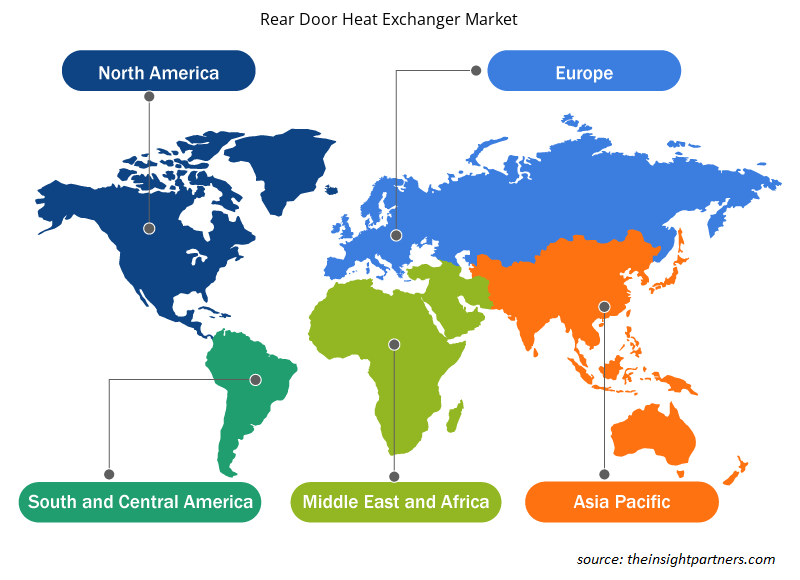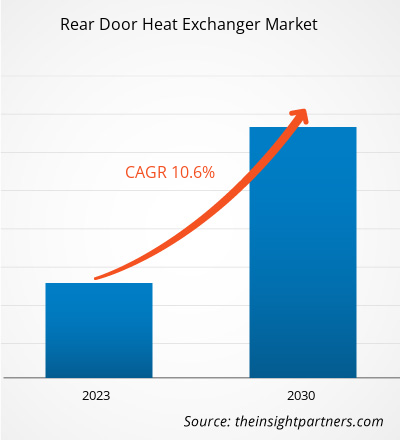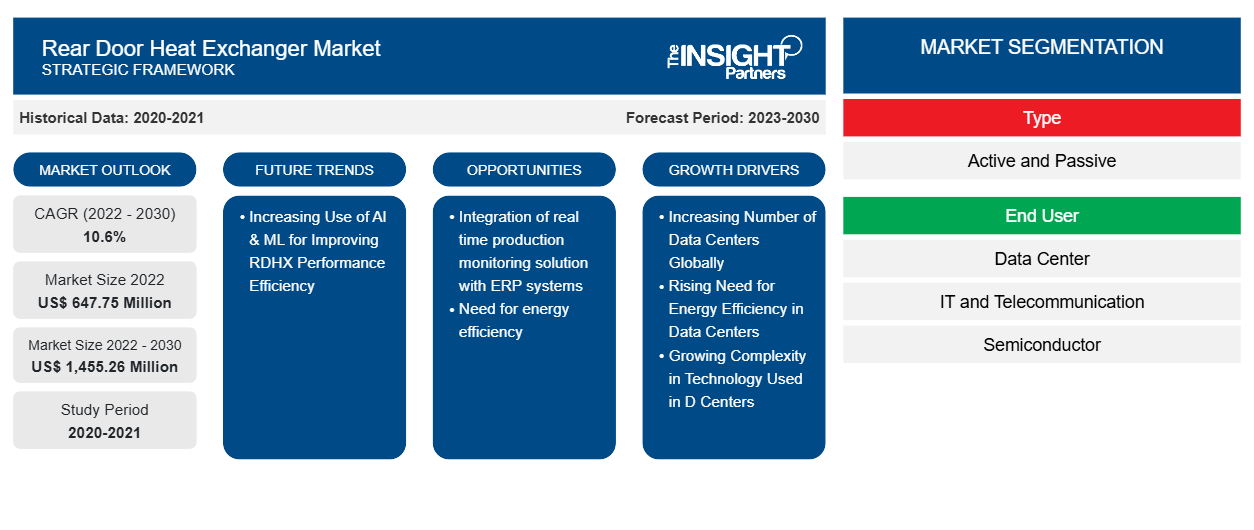[تقرير بحثي] تم تقييم حجم سوق المبادل الحراري للباب الخلفي بـ 647.75 مليون دولار أمريكي في عام 2022 ومن المتوقع أن يصل إلى 1،455.26 مليون دولار أمريكي بحلول عام 2030 ؛ ومن المتوقع أن يسجل معدل نمو سنوي مركب بنسبة 10.6٪ من عام 2022 إلى عام 2030.
وجهة نظر المحلل:
تُستخدم المنتجات في سوق المبادلات الحرارية للباب الخلفي كآلية تبريد في الغالب في مراكز البيانات عالية الكثافة إلى جانب الصناعات الحيوية الأخرى مثل الأدوية والمواد الكيميائية للتبريد المستهدف. وقد ثبت أن المنتجات في سوق المبادلات الحرارية للباب الخلفي فعالة للاستخدام في مراكز البيانات لتبريد رف الخادم إما بشكل نشط أو سلبي. يتم تثبيتها مباشرة على الباب الخلفي لرفوف الخادم وتعمل بشكل مستقل عن أنظمة التبريد المركزية. ومن المتوقع أن يؤدي زيادة عدد مراكز البيانات في جميع أنحاء العالم والاهتمام المتزايد بكفاءة الطاقة في مراكز البيانات هذه إلى تغذية نمو سوق المبادلات الحرارية للباب الخلفي.
نظرة عامة على سوق المبادل الحراري للباب الخلفي:
المبادل الحراري للباب الخلفي هو جهاز ينقل الحرارة بين سائلين دون خلطهما. تُستخدم المبادلات الحرارية للباب الخلفي في تطبيقات مختلفة، بما في ذلك مراكز البيانات والتعليم والحكومة وتكنولوجيا المعلومات والاتصالات. تتوفر المبادلات الحرارية للباب الخلفي بنوعين: المبادلات الحرارية للباب الخلفي السلبية والمبادلات الحرارية للباب الخلفي النشطة. تُستخدم المبادلات الحرارية للباب الخلفي (RDHx) بشكل خاص في بيئات الخوادم الكثيفة في أي مركز بيانات. RDHx هو نوع من حلول التبريد المستخدمة في مراكز البيانات والتي تعمل عن طريق إزالة الحرارة من الهواء العادم لمعدات تكنولوجيا المعلومات باستخدام مبادل حراري مثبت في الجزء الخلفي من رف الخادم. ثم يتم إعادة تدوير الهواء المبرد إلى مركز البيانات، مما يقلل من الحاجة إلى وحدات تكييف الهواء التقليدية في غرفة الكمبيوتر (CRAC). يمكن أن يكون RDHx طريقة فعالة لتبريد الهواء في مراكز البيانات في ظل ظروف معينة، مثل الحمل الحراري والمناخ وتصميم الخادم والصيانة. يكون RDHx أكثر كفاءة عندما يكون الحمل الحراري مرتفعًا وكثافة معدات تكنولوجيا المعلومات عالية.
يُطلق المصنعون في سوق المبادلات الحرارية للباب الخلفي منتجات مختلفة لتلبية الطلب في سوق المبادلات الحرارية للباب الخلفي. على سبيل المثال، في مايو 2023، أعلنت CoolIT Systems عن توسيع محفظتها لتشمل أول مبادل حراري للباب الخلفي مزود بالتبريد السائل المباشر (DLC). ومن المتوقع أن تستهلك مراكز البيانات 8% من كهرباء العالم بحلول عام 2030، مما يستلزم تبني حلول تعالج التحدي بشكل فعال. يوفر RDHx تقنية تبريد متقدمة للعملاء الذين يستخدمون التبريد السائل المباشر. تتعاون العديد من شركات تصنيع المبادلات الحرارية للباب الخلفي مع لاعبين آخرين في السوق لتقديم مبادلات حرارية جديدة للباب الخلفي.
قم بتخصيص هذا التقرير ليناسب متطلباتك
ستحصل على تخصيص لأي تقرير - مجانًا - بما في ذلك أجزاء من هذا التقرير، أو تحليل على مستوى الدولة، وحزمة بيانات Excel، بالإضافة إلى الاستفادة من العروض والخصومات الرائعة للشركات الناشئة والجامعات
-
احصل على أهم اتجاهات السوق الرئيسية لهذا التقرير.ستتضمن هذه العينة المجانية تحليلاً للبيانات، بدءًا من اتجاهات السوق وحتى التقديرات والتوقعات.
محرك سوق المبادل الحراري للباب الخلفي:
التعقيد المتزايد في التكنولوجيا المستخدمة في مراكز البيانات يدفع سوق المبادلات الحرارية ذات الباب الخلفي إلى النمو
تعتمد مراكز البيانات على تقنيات الحوسبة عالية الأداء (HPC) لمهام مثل البحث العلمي والمحاكاة وتحليل البيانات. تولد هذه الأنظمة أحمال حرارية كبيرة بسبب كثافتها الحسابية العالية. توفر المبادلات الحرارية للباب الخلفي تبريدًا فعالًا لهذه البيئات عالية الكثافة. كما أن مراكز البيانات عند مفترق طرق. الطلب على الحوسبة والتخزين وقدرة الاتصالات ينمو بسرعة. تستهلك معدات تكنولوجيا المعلومات المزيد من الطاقة وتولد المزيد من الحرارة. ومن المتوقع أن ترتفع أسعار الكهرباء في السنوات القادمة. وفي الوقت نفسه، تجبر الضغوط التجارية والاقتصادية الشركات على دمج المرافق وتبسيط العمليات وخفض تكاليف تكنولوجيا المعلومات بشكل كبير. مع زيادة متوسط كثافة الحرارة لكل حاوية، يصبح توفير التبريد اللازم لتشغيل مركز البيانات بشكل صحيح مشكلة متزايدة. في بعض الأحيان، يكون التبريد الذي يجب توفيره ضعف ما تتطلبه الأحمال الحرارية بدقة بسبب عدم الكفاءة داخل نظام التبريد. يمكن أن تحتوي هذه الحلول على كثافات حرارية عالية، مما يجعل التبريد الدقيق ضروريًا. تساعد المبادلات الحرارية للباب الخلفي في الحفاظ على درجة الحرارة المطلوبة لمثل هذه البنية التحتية. ونتيجة لهذه الأسباب، يتزايد الطلب على المبادلات الحرارية للباب الخلفي في مراكز البيانات لزيادة كفاءة التبريد.
علاوة على ذلك، في مراكز البيانات متعددة المستأجرين ومراكز البيانات المشتركة، يمكن أن تؤدي متطلبات العملاء المتنوعة وتكوينات المعدات إلى ملفات تعريف حرارية متنوعة. توفر المبادلات الحرارية للباب الخلفي حل تبريد مرن وموضعي يمكن تصميمه وفقًا لاحتياجات العملاء الفردية. توفر المبادلات الحرارية للباب الخلفي تبريدًا على مستوى الرف، وهو ما يتماشى مع الاتجاه نحو تصميمات مراكز البيانات المعيارية والقائمة على الرفوف. يمكن تركيبها مباشرة على رفوف الخادم، مما يوفر تبريدًا دقيقًا حيث تكون هناك حاجة إليه أكثر. وبالتالي، مع التعقيدات المتزايدة في التكنولوجيا المستخدمة في مراكز البيانات، يتزايد الطلب على المبادلات الحرارية للباب الخلفي، مما يعزز نمو سوق المبادلات الحرارية للباب الخلفي.
تحليل قطاعي لسوق المبادل الحراري للباب الخلفي:
بناءً على النوع، يتم تقسيم سوق المبادل الحراري للباب الخلفي إلى نشط وسالب. المنتجات في سوق المبادل الحراري للباب الخلفي مثالية لدعم مراكز البيانات عالية الكثافة. تطلق العديد من الشركات المصنعة في سوق المبادل الحراري للباب الخلفي مبادلات حرارية للباب الخلفي من النوع النشط لتطبيقات تبريد مراكز البيانات . على سبيل المثال، في يونيو 2019، أطلقت شركة Nortek Air Solutions خط منتجات المبادلات الحرارية للباب الخلفي ServerCool. أطلقت شركة Nortek Air Solutions مبادلات الحرارة النشطة للباب الخلفي ADHX 35-6B لتطبيقات تبريد مراكز البيانات. يعد ADHX 35-6B الجيل التالي من ADHX الناجح من ServerCool، حيث يوفر تحسينات في مجالات التكرار في المبادل الحراري للباب الخلفي وسهولة الاستخدام والمتانة وكفاءة الطاقة. يتفوق ADHX 35-6B على مبادلات ADHX الأخرى في صناعة مراكز البيانات من حيث التكلفة الإجمالية للملكية (TCO) وكفاءة استهلاك الطاقة (PUE). بالإضافة إلى ذلك، فهو يوفر تصميمًا هندسيًا مثبتًا يقلل من تكاليف التركيب والصيانة. يعد هذا التصميم المحسن مناسبًا للتحديثات ومراكز البيانات الجديدة ذات أنظمة المياه المبردة، حيث يستهلك أقل من 500 واط من الطاقة مقابل 35 كيلو واط من سعة التبريد ويساهم في قيمة PUE تبلغ 1.033 فقط.
تحليل إقليمي لسوق المبادل الحراري للباب الخلفي:
تم تقييم حجم سوق المبادل الحراري للباب الخلفي في أمريكا الشمالية بـ 265.64 مليون دولار أمريكي في عام 2022 ومن المتوقع أن يصل إلى 586.27 مليون دولار أمريكي بحلول عام 2030 ؛ ومن المتوقع أن يسجل معدل نمو سنوي مركب بنسبة 10.4٪ من عام 2022 إلى عام 2030. يتم تقسيم سوق المبادل الحراري للباب الخلفي في أمريكا الشمالية إلى الولايات المتحدة وكندا والمكسيك. تلعب مراكز البيانات دورًا حاسمًا في مستقبل اقتصاد أمريكا الشمالية. مع انتقال المزيد من الشركات والمستخدمين إلى المجال الرقمي، تتزايد الحاجة إلى معالجة المعلومات بكفاءة. مراكز البيانات هي موصلات لشبكات الاتصالات، لذلك يمكن للمستخدمين الوصول السريع إلى المعلومات حتى من خلال العمل عن بُعد. وفقًا لتقرير لجنة التجارة الدولية الأمريكية (USITC)، من المتوقع أن تبلغ قيمة قطاع مراكز البيانات في الولايات المتحدة 99.97 مليار دولار أمريكي في عام 2023. يوجد 8000 مركز بيانات في جميع أنحاء العالم. ومن بين هذه المراكز، يقع 33٪ من مراكز البيانات في الولايات المتحدة. إن أهم خمسة محركات لسوق مراكز البيانات في أمريكا الشمالية هي الرقمنة والعمل عن بعد والتكنولوجيات الرقمية والذكاء الاصطناعي والتعلم الآلي وخدمات OTT وإنترنت الأشياء. وفي المنطقة، لا يُظهر نمو مراكز البيانات أي علامة على التباطؤ. فالطلب على المزيد من الوصول الرقمي والتخزين وعمليات البيانات آخذ في الارتفاع باستمرار. وعلاوة على ذلك، وفقًا لإحصاءات كندا، كانت نسبة الموظفين في سن العمل الأساسي الذين يعملون من المنزل حوالي 43% في مايو 2020 في كندا. وبحلول ديسمبر 2021، عمل 26% من الموظفين في سن العمل الأساسي في كندا من المنزل. وأفاد 90% من العاملين عن بعد بمعدلات إنتاجية ثابتة أو أعلى عند العمل عن بعد، مقارنة بالعمل في المكتب، وفضل 41% من العاملين عن بعد العمل عن بعد لنصف ساعات عملهم الأسبوعية. ويعني الجمع بين المجتمع المتمرس في التكنولوجيا واتجاهات العمل عن بعد زيادة دائمة في حجم سوق مراكز البيانات في أمريكا الشمالية.
بالإضافة إلى ذلك، هناك سببان آخران لنمو مراكز البيانات: إنترنت الأشياء (IoT) والذكاء الاصطناعي. مع اتصال المزيد والمزيد من الأجهزة بالإنترنت يوميًا، تتزايد كمية البيانات التي يتم إنشاؤها. وبالتالي، هناك حاجة إلى المزيد من مراكز البيانات في المنطقة لتخزين هذه البيانات الضخمة. تُستخدم المنتجات في سوق المبادل الحراري للباب الخلفي على نطاق واسع في مراكز البيانات للحفاظ على فصل تيارات الهواء عن طريق نقل الحرارة من الداخل إلى الخارج لمبنى مركز البيانات. وبالتالي، مع الطلب المتزايد على مراكز البيانات في أمريكا الشمالية، تزداد الحاجة إلى المنتجات في سوق المبادل الحراري للباب الخلفي بشكل كبير.
تحليل اللاعبين الرئيسيين في سوق المبادل الحراري للباب الخلفي:
تعد Coolcentric وNortek Air Management وUSystems Limited وCOOLIT SYSTEMS وnVent Electric plc وVertiv Group Corp وSTULZ GMBH وMotivair Corporation وIBM وAiredale من بين اللاعبين الرئيسيين الذين يعملون في سوق المبادل الحراري للباب الخلفي.
رؤى إقليمية حول سوق المبادل الحراري للباب الخلفي
لقد قام المحللون في Insight Partners بشرح الاتجاهات والعوامل الإقليمية المؤثرة على سوق المبادل الحراري للباب الخلفي طوال فترة التوقعات بشكل شامل. يناقش هذا القسم أيضًا قطاعات سوق المبادل الحراري للباب الخلفي والجغرافيا في جميع أنحاء أمريكا الشمالية وأوروبا ومنطقة آسيا والمحيط الهادئ والشرق الأوسط وأفريقيا وأمريكا الجنوبية والوسطى.

- احصل على البيانات الإقليمية المحددة لسوق المبادل الحراري للباب الخلفي
نطاق تقرير سوق المبادل الحراري للباب الخلفي
| سمة التقرير | تفاصيل |
|---|---|
| حجم السوق في عام 2022 | 647.75 مليون دولار أمريكي |
| حجم السوق بحلول عام 2030 | 1,455.26 مليون دولار أمريكي |
| معدل النمو السنوي المركب العالمي (2022 - 2030) | 10.6% |
| البيانات التاريخية | 2020-2021 |
| فترة التنبؤ | 2023-2030 |
| القطاعات المغطاة |
حسب النوع
|
| المناطق والدول المغطاة |
أمريكا الشمالية
|
| قادة السوق وملفات تعريف الشركات الرئيسية |
|
كثافة اللاعبين في السوق: فهم تأثيرها على ديناميكيات الأعمال
يشهد سوق المبادلات الحرارية للباب الخلفي نموًا سريعًا، مدفوعًا بالطلب المتزايد من المستخدم النهائي بسبب عوامل مثل تفضيلات المستهلكين المتطورة والتقدم التكنولوجي والوعي المتزايد بفوائد المنتج. ومع ارتفاع الطلب، تعمل الشركات على توسيع عروضها والابتكار لتلبية احتياجات المستهلكين والاستفادة من الاتجاهات الناشئة، مما يؤدي إلى زيادة نمو السوق.
تشير كثافة اللاعبين في السوق إلى توزيع الشركات أو المؤسسات العاملة في سوق أو صناعة معينة. وهي تشير إلى عدد المنافسين (اللاعبين في السوق) الموجودين في مساحة سوق معينة نسبة إلى حجمها أو قيمتها السوقية الإجمالية.
الشركات الرئيسية العاملة في سوق المبادل الحراري للباب الخلفي هي:
- مركزية باردة
- شركة ستولز المملكة المتحدة المحدودة
- نورتيك للحلول الجوية، ذ.م.م
- شركة نفينت للكهرباء
- شركة الآلات التجارية الدولية
إخلاء المسؤولية : الشركات المذكورة أعلاه ليست مرتبة بأي ترتيب معين.

- احصل على نظرة عامة على أهم اللاعبين الرئيسيين في سوق المبادل الحراري للباب الخلفي
التطورات الأخيرة:
تتبنى الشركات في سوق المبادلات الحرارية ذات الأبواب الخلفية بشكل كبير الاستراتيجيات العضوية وغير العضوية مثل عمليات الدمج والاستحواذ. فيما يلي بعض التطورات الرئيسية الأخيرة في سوق المبادلات الحرارية ذات الأبواب الخلفية:
- في يناير 2019، قدمت شركة Nortek Air Solutions منتج ADHX 35-6B، وهو مبادل حراري خلفي نشط بقوة 35 كيلو وات إلى خط منتجات التبريد السائل لمركز البيانات ServerCool™. يعد ADHX 35-6B الجيل التالي من ADHX الناجح من ServerCool، ويتميز بترقيات في التكرار وسهولة الاستخدام والمتانة وكفاءة الطاقة.
- في أغسطس 2021، أعلنت شركة USystems Ltd، الشركة المتخصصة في تصنيع حلول تبريد مراكز البيانات، وشركة Rahi Systems، الشركة المتخصصة في تصميم وتوريد وتركيب حلول مراكز البيانات، عن شراكتهما لتوفير الإمدادات والتركيب العالمي لمبادلات الحرارة ذات الباب الخلفي ColdLogik (RDHX) ومبردات الصفوف من شركة USystems.
- التحليل التاريخي (سنتان)، سنة الأساس، التوقعات (7 سنوات) مع معدل النمو السنوي المركب
- تحليل PEST و SWOT
- حجم السوق والقيمة / الحجم - عالمي، إقليمي، بلد
- الصناعة والمنافسة
- مجموعة بيانات إكسل
التقارير الحديثة
تقارير ذات صلة
شهادات العملاء
سبب الشراء
- اتخاذ قرارات مدروسة
- فهم ديناميكيات السوق
- تحليل المنافسة
- رؤى العملاء
- توقعات السوق
- تخفيف المخاطر
- التخطيط الاستراتيجي
- مبررات الاستثمار
- تحديد الأسواق الناشئة
- تحسين استراتيجيات التسويق
- تعزيز الكفاءة التشغيلية
- مواكبة التوجهات التنظيمية























 احصل على عينة مجانية ل - سوق المبادل الحراري للباب الخلفي
احصل على عينة مجانية ل - سوق المبادل الحراري للباب الخلفي